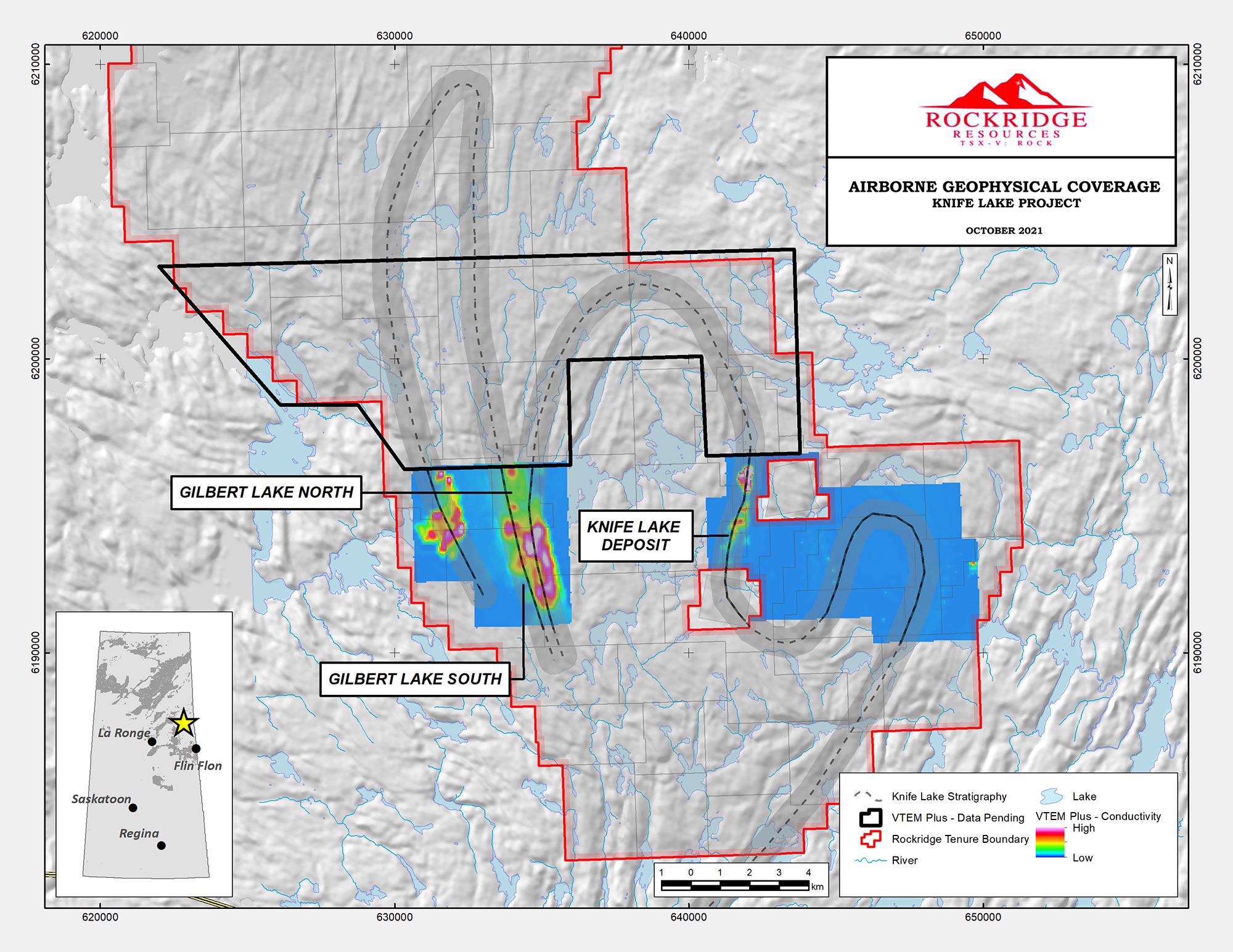Rockridge Resources has reported that its geophysical program at the Knife Lake Copper Project situated in Saskatchewan, Canada has been completed.
 Knife Lake VMS Project Location Map. Image Credit: Rockridge Resources
Knife Lake VMS Project Location Map. Image Credit: Rockridge Resources
The Knife Lake Project has 81 claims adding up to 55,471 hectares (137,069 acres). Located in Saskatchewan, it is an advanced-stage copper, zinc, silver and cobalt exploration property host to the Knife Lake Deposit. Extra fieldwork is scheduled to start soon in preparation for a diamond drill program.
Field crews have finished a helicopter-borne electromagnetic (EM) and horizontal magnetic gradiometer geophysical survey employing Geotech Ltd.’s VTEM Plus System. The 610-line kilometer survey covered very promising VMS stratigraphy in the Gilbert Lake target area. This area has never before been explored using the latest time-domain geophysics.
Data from the survey is at present being deduced and any prospective conductors will be selected for geophysical modeling. Mineralized drill intersections at the Gilbert Lake target area have established that VTEM plus is a valuable exploration tool for detecting VMS-style mineralization within potential stratigraphy on the Property, boosting discovery possibilities in regional target areas.
Modern exploration tools such as airborne electromagnetic and horizontal geophysical surveys have been and will continue to be an important part of ROCK’s exploration strategy at Knife Lake. We have been using these and exploration techniques to identify new and prospective target areas in and around the existing Knife Lake deposit.
Jonathan Wiesblatt, CEO, Rockridge
“The deposit was first discovered many decades ago but the project overall has yet to be the beneficiary of a thorough and complete, modern-day exploration campaign at its regional target areas. The current and upcoming exploration work will help us to commence another diamond-drilling program to follow up on historical results and test new targets,” he added.
Knife Lake Geology and History
The Knife Lake Deposit is understood to be a remobilized VMS deposit. The stratabound mineralized zone is about 15 m thick and comprises zinc, copper, gold silver and cobalt mineralization which dips 30° to 50° eastward over an identified strike-length within the 3,700 m claim area of Rockridge, and a known average down-dip extension of about 300 m.
The deposit holds felsic to intermediate volcanic and volcaniclastic rocks, which have been metamorphosed into upper amphibolite facies. The deposit has VMS mineralogy which has been considerably altered and partially remobilized during the emplacement of granitic rocks. The mineralization overlaps the boundary between two rock units and is seen on both limbs of an interpreted overturned fold.
During the 2019 and 2021 winter drilling programs, the Company has finished twenty-four holes comprising 3,096 m of diamond drilling. This was the first drilling on the property since 2001.
The two programs have provided the Company’s technical team with crucial insights into the property geology, alteration and mineralization that will be exploited in future regional exploration on the extremely promising and underexplored land package.
Highpoints from the drill programs consist of formerly reported hole KF19003 which intersected net-textured to semi-massive sulfide mineralization from 11.2 m to 48.8 m downhole. This 37.6 m interval yielded 0.19 g/t Au, 2.03% Cu, 0.36% Zn, 9.88 g/t Ag and 0.01% Co for a projected 2.42% CuEq.
Moreover, formerly reported drill hole KF19001 intersected net-textured to fracture-controlled sulfide mineralization from 7.5 m to 40.6 m downhole. This 33.1 m interval returned 0.12 g/t Au, 1.28% Cu, 0.13% Zn, 4.80 g/t Ag and 0.01% Co for an estimated 1.49% CuEq.
In August 2019, Rockridge reported a maiden NI 43-101 resource projection for the Knife Lake deposit which was made up of a pit-constrained indicated resource of 3.8 million tons at 1.02% CuEq and an inferred resource of 7.9 million ton at 0.67% CuEq using a 0.4% CuEq cut-off.
Qualified Person
Kerry Bates, P. Geo., a “qualified person” for the purposes of National Instrument 43-101 - Standards of Disclosure for Mineral Projects, and a Geologist employed by TerraLogic Exploration Inc., has assessed and approved the technical and scientific disclosure in this article relating to the Knife Lake Project.